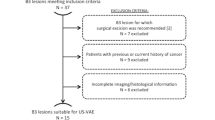Abstract
Purpose
The aim of this study was to analyze the role of ultrasound-guided vacuum-assisted excision (US-guided VAE) in the treatment of high-risk breast lesions and to evaluate the clinical and US features of the patients associated with recurrence or development of malignancy.
Materials and methods
Between April 2010 and September 2021, 73 lesions of 73 patients underwent US-guided VAE and were diagnosed with high-risk breast lesions. The incidence of recurrence or development of malignancy for high-risk breast lesions was evaluated at follow-up period. The clinical and US features of the patients were analyzed to identify the factors affecting the recurrence or development of malignancy rate.
Results
Only benign phyllodes tumors on US-guided VAE showed recurrences, while other high-risk breast lesions that were atypical ductal hyperplasia (ADH), lobular neoplasia (atypical lobular hyperplasia/lobular carcinoma in situ), radial scar, and flat epithelial atypia did not show recurrences or malignant transformation. The recurrence rate of the benign phyllodes tumor was 20.8% (5/24) in a mean follow-up period of 34.3 months. The recurrence rate of benign phyllodes tumor with distance from nipple of less than 1 cm was significantly higher than that of lesions with distance from nipple of more than 1 cm (75% vs. 10%, p < 0.05).
Conclusions
Benign phyllodes tumors without concurrent breast cancer could be safely followed up instead of surgical excision after US-guided VAE when the lesions were classified as BI-RADS 3 or 4A by US.
Similar content being viewed by others
References
Lewin AA, Mercado CL (2020) Atypical ductal hyperplasia and lobular neoplasia: update and easing of guidelines. AJR Am J Roentgenol 214:265–275
Morrow M, Schnitt SJ, Norton L (2015) Current management of lesions associated with an increased risk of breast cancer. Nat Rev Clin Oncol 12:227–238
Heller SL, Moy L (2012) Imaging features and management of high-risk lesions on contrast-enhanced dynamic breast MRI. AJR Am J Roentgenol 198:249–255
Thomas PS (2018) Diagnosis and management of high-risk breast lesions. J Natl Compr Canc Netw 16:1391–1396
Degnim AC, King TA (2013) Surgical management of high-risk breast lesions. Surg Clin North Am 93:329–340
Cha E, Ambinder EB, Oluyemi ET et al (2022) High-risk lesions in the breast diagnosed by MRI-guided core biopsy: upgrade rates and features associated with malignancy. Breast Cancer Res Treat 196:517–525
Bennett I, de Viana D, Law M et al (2020) Surgeon-performed vacuum-assisted biopsy of the breast: results from a multicentre Australian study. World J Surg 44:819–824. https://doi.org/10.1007/s00268-019-05266-7
Bennett IC, Saboo A (2019) The evolving role of vacuum assisted biopsy of the breast: a progression from fine-needle aspiration biopsy. World J Surg 43:1054–1061. https://doi.org/10.1007/s00268-018-04892-x
Mooney KL, Bassett LW, Apple SK (2016) Upgrade rates of high-risk breast lesions diagnosed on core needle biopsy: a single-institution experience and literature review. Mod Pathol 29:471–1484
Graham CL (2017) Evaluation of percutaneous vacuum assisted intact specimen breast biopsy device for ultrasound visualized breast lesions: upstage rates and long term follow-up for high risk lesions and DCIS. Breast 33:38–43
Gumus H, Mills P, Gumus M et al (2013) Factors that impact the upgrading of atypical ductal hyperplasia. Diagn Interv Radiol 19:91–96
Winchester DJ, Bernstein JR, Jeske JM et al (2003) Upstaging of atypical ductal hyperplasia after vacuum-assisted 11-gauge stereotactic core needle biopsy. Arch Surg 138:619–622
Schiaffino S, Massone E, Gristina L et al (2018) Vacuum assisted breast biopsy (VAB) excision of subcentimeter microcalcifications as an alternative to open biopsy for atypical ductal hyperplasia. Br J Radiol 91:20180003
Ferre R, Omeroglu A, Mesurolle B (2017) Sonographic appearance of lesions diagnosed as lobular neoplasia at sonographically guided biopsies. AJR Am J Roentgenol 208:669–675
Adrales G, Turk P, Wallace T et al (2000) Is surgical excision necessary for atypical ductal hyperplasia of the breast diagnosed by Mammotome? Am J Surg 180:313–315
Khoury T, Chen X, Wang D et al (2015) Nomogram to predict the likelihood of upgrade of atypical ductal hyperplasia diagnosed on a core needle biopsy in mammographically detected lesions. Histopathology 67:106–120
McCroskey Z, Sneige N, Herman CR et al (2018) Flat epithelial atypia in directional vacuum-assisted biopsy of breast microcalcifications: surgical excision may not be necessary. Mod Pathol 31:1097–1106
Latronico A, Nicosia L, Faggian A et al (2018) A typical ductal hyperplasia: our experience in the management and long term clinical follow-up in 71 patients. Breast 37:1–5
Shang QJ, Li N, Zhang MK et al (2020) Ultrasound-guided vacuum-assisted excisional biopsy to treat benign phyllodes tumors. Breast 49:242–245
Park HL, Pyo YC, Kim KY et al (2018) Recurrence rates and characteristics of phyllodes tumors diagnosed by ultrasound-guided vacuum-assisted breast biopsy (VABB). Anticancer Res 38:5481–5487
Bhatt AA, Whaley DH, Lee CU (2021) Ultrasound-guided breast biopsies: basic and new techniques. J Ultrasound Med 40:1427–1443
Funding
This research did not receive any specific grant from funding agencies in the public, commercial, or not-for-profit sectors.
Author information
Authors and Affiliations
Corresponding author
Ethics declarations
Conflict of interest
The authors declare that they have no conflict of interest.
Informed consent
This retrospective study was approved by our institutional review board, and the requirement to obtain informed consent was waived.
Additional information
Publisher's Note
Springer Nature remains neutral with regard to jurisdictional claims in published maps and institutional affiliations.
Rights and permissions
Springer Nature or its licensor (e.g. a society or other partner) holds exclusive rights to this article under a publishing agreement with the author(s) or other rightsholder(s); author self-archiving of the accepted manuscript version of this article is solely governed by the terms of such publishing agreement and applicable law.
About this article
Cite this article
He, P., Lei, YT., Zhao, HM. et al. High-Risk Breast Lesions Diagnosed by Ultrasound-Guided Vacuum-Assisted Excision. World J Surg 47, 1247–1252 (2023). https://doi.org/10.1007/s00268-023-06930-9
Accepted:
Published:
Issue Date:
DOI: https://doi.org/10.1007/s00268-023-06930-9




